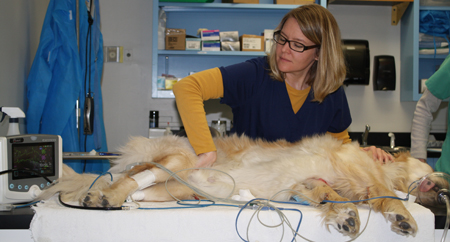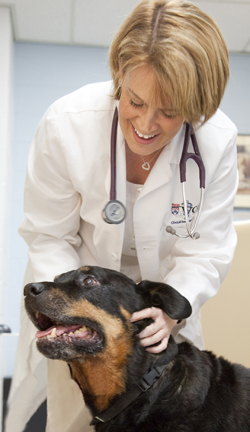
Last summer Jeff Gillman noticed that his German shepherd mix, Reuben, had lost a lot of weight. After examining the dog, Reuben’s veterinarian told Gillman to take him to a specialty animal hospital right away. Gillman knew just where to go: Penn Vet’s Ryan Hospital. “It’s the best emergency hospital,” he said.
Penn veterinarians removed Reuben’s spleen and did a biopsy. Back came the dreaded diagnosis of hemangiosarcoma, an aggressive cancer of the blood vessels, and a grim prognosis of two-to-four months without treatment and four-to-six months with chemotherapy.
“I was crushed, absolutely crushed,” Gillman said. A dozen years earlier he had picked Reuben from a litter of puppies at a farmers market in Santa Cruz. Reuben rode in Gillman’s backpack, with his paws hanging out, as they traveled the West Coast that summer after Gillman’s freshman year of college. “At this point, he’s one of my oldest friends,” Gillman said.
So Gillman leapt at the opportunity when the veterinarians at Ryan Hospital told him about a study Reuben could participate in through Penn Vet’s Veterinary Clinical Investigations Center (VCIC). The study compares the effects of the traditional Chinese medicine I’m-Yunity, a compound derived from the Coriolus versicolor mushroom, to standard chemotherapy treatment on survival time and quality of life for dogs with splenic hemangiosarcoma.
Dr. Dorothy Cimino Brown is director of the VCIC and a board-certified small animal surgeon. In a published study, Brown and Jennifer Reetz, an attending radiologist, showed that dogs with hemangiosarcoma that were treated with I’m-Yunity had the longest survival time reported for dogs with the disease. The VCIC is collaborating on the study with a Chinese company that seeks to apply the Western scientific method to Eastern medicine.
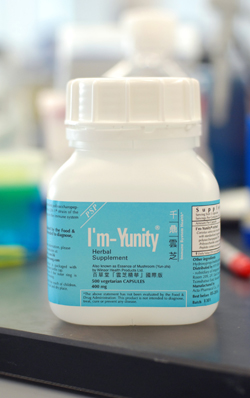 Reuben’s study is divided into three groups. One group is being treated with chemotherapy alone. A second group is being treated with I’m-Yunity alone. And a third group is being treated with both chemotherapy and I’m-Yunity. Gillman doesn’t know which group Reuben is in, but he believes it’s one of the groups getting I’m-Yunity. It has been a year since Reuben’s diagnosis, and he’s still going strong.
Reuben’s study is divided into three groups. One group is being treated with chemotherapy alone. A second group is being treated with I’m-Yunity alone. And a third group is being treated with both chemotherapy and I’m-Yunity. Gillman doesn’t know which group Reuben is in, but he believes it’s one of the groups getting I’m-Yunity. It has been a year since Reuben’s diagnosis, and he’s still going strong.
The VCIC was created in 2005 to support Penn Vet investigators engaged in clinical research and to coordinate clinical trials of novel approaches for treating, managing, and preventing disease in animals.
“I love research and solving problems to make life better,” said Penn Vet Dean Joan Hendricks, who founded the VCIC. Section chief for critical care at Ryan Hospital at the time, she envisioned a research center where “our animal patients might be able to get access to new treatments and interventions,” often at less or no expense to the client. And the infrastructure would assist Penn Vet investigators with monitoring their subjects and meeting regulatory requirements, she said.
The center would translate research on novel treatments that began in lab animal studies to trials in companion animals that develop many of the same diseases as people.
The VCIC’s first clinical trial was sponsored by Pfizer Animal Health, the result of an idea pitched to them by Hendricks. After nearly two years of negotiations, Hendricks felt confident that the VCIC model would work. “We always made sure there was something we could publish, no matter what,” she noted.
But Hendricks worried about the clients. Would they understand the risks and the lack of guarantees for their beloved pets? To ensure that clients do, VCIC staff conducts a rigorous informed-consent process, and Hendricks has been overwhelmed by their altruistic attitude. “It’s very important to them that their pet helps another animal. They go into it with their eyes open,” she said.
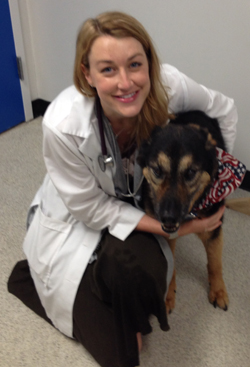 In addition, clients’ pets are “getting access to potential interventions that they wouldn’t otherwise have access to anywhere else,” Brown noted. In post-study surveys, clients routinely say they appreciate the frequent contact they have with the clinical trials nurses, including being given cell phone numbers if they have questions or problems.
In addition, clients’ pets are “getting access to potential interventions that they wouldn’t otherwise have access to anywhere else,” Brown noted. In post-study surveys, clients routinely say they appreciate the frequent contact they have with the clinical trials nurses, including being given cell phone numbers if they have questions or problems.
Gillman sounded pleased about the care Reuben receives as part of the I’m-Yunity study. “He goes there and he has a nurse. They treat him like he’s the only [patient],” Gillman said.
More than three-fourths of clients participating in VCIC studies are new to Penn Vet, Brown noted. At the end of their studies, more than 90 percent say they would consider returning.
The VCIC began with one principal investigator (Brown), one veterinary nurse, and one study. It has grown to include the participation of dozens of investigators aided by five veterinary clinical trials nurses.
Brown is responsible for one of the VCIC’s biggest successes so far. She collaborated with Dr. Michael Iadarola to study resiniferatoxin (RTX)—a naturally occurring substance from a Moroccan cactus-like succulent plant—as a potential treatment for chronic pain from canine bone cancer. They gave dogs one injection of RTX into the fluid around the spinal cord.
“The effect was stunning,” said Iadarola, a senior research scientist at the National Institutes of Health. An article from the May-June 2006 NIH Catalyst noted that: “All of the dogs experienced significant pain relief that lasted for the rest of their lives.”
Iadarola said such results with dogs provided a “tremendous incentive” to move to human trials—the first of which, involving patients with advanced cancer, is going on now. RTX initially had been tested on rodents. “To go directly from the rat to the human was a pretty big step,” he said. Often such large leaps in drug testing result in a high failure rate, Brown said, because the pre-clinical models don’t mimic what goes on with people, and the disease is artificially induced in the rodents.
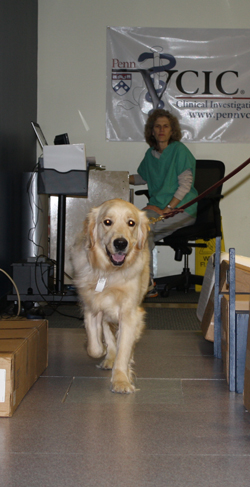 But when testing makes a stop in between with companion animals, they “share the same environment [with humans]. Many of the same risk factors are going to be present as in people,” Brown said. That makes the results more likely to be replicable in humans. As Hendricks noted, the loss of laboratory conditions “makes the science much harder and much, much closer to reality.”
But when testing makes a stop in between with companion animals, they “share the same environment [with humans]. Many of the same risk factors are going to be present as in people,” Brown said. That makes the results more likely to be replicable in humans. As Hendricks noted, the loss of laboratory conditions “makes the science much harder and much, much closer to reality.”
Studies with companion animals also allow researchers to better gauge a drug’s possible side effects. Owners can assess their dog’s pain, bladder and bowel function, and activity level at home, and notice any personality changes, Iadarola said.
It is a natural progression for the only veterinary school in the country founded through a medical school to also be the first to create a research facility dedicated to translational research. The VCIC exemplifies Penn Vet’s longstanding commitment to One Health, which aims to advance health care and well-being for animals and humans through collaborative, interdisciplinary practices. The VCIC’s goal is to get cutting-edge therapies to patients—both animal and human—as efficiently as possible.
The VCIC has completed 46 studies, according to Managing Director Michael DiGregorio. Currently, 19 trials involving 18 faculty members are underway, and another six trials are being planned. While all VCIC studies have applications to animal health, about half the trials running now have sponsors that are ultimately interested in application of the results to human health as well, Brown said.
Industry representatives, government organizations, individuals, and foundations fund the VCIC’s studies, DiGregorio said. Subjects are recruited using traditional advertising, web and social media, and through the network of more than 3,000 veterinary practices that refer the pets that make the 30,000 visits to Ryan Hospital each year.
The VCIC recently finished its first large animal study at New Bolton Center, which looked at a novel estrus synchronization protocol in cows. Another large animal trial—studying risk assessment of cross-contamination among different species including cows, goats, and sheep—is underway, DiGregorio said.
Gillman finds universal and personal value in the VCIC’s work. Reuben’s participation in a study may lead to better prognoses for dogs with the same kind of cancer in the future. “I’m glad that Reuben gets to help. We take that seriously,” Gillman said. “I think the study has been a blessing. I don’t think that he would have lasted a year. The study has allowed me to really cherish and enjoy him.”
